
June 20-21, 2020 – Butte Tribe Hosts Ceremony of Feathers


Written by: Belinda Brooks
Storyteller: Chief Rodger Collum
Note from the author: In the future, I will publish stories from our Chief Storyteller of his life and the life of past chiefs that have not been published in local newspapers. There are hundreds of stories to reveal as they come to his memory. We have only touch the surface of tales to tell.
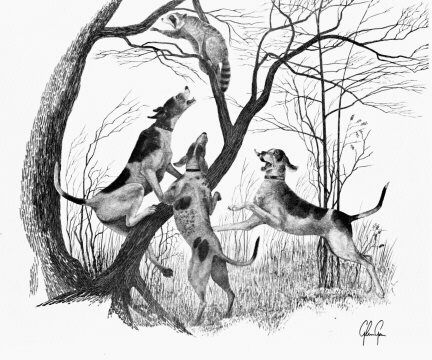
Chief Collum’s closeness to nature is obvious wherever he goes. In his 67 years, there is barely a foot of land on Bayou Bourbeaux that he is not innately aware of. Should one be so fortunate as to spend the day with him sightseeing, his stories about each location whether it be during the days of his ancestors or his lifetime will captivate the listener.
Collum has been active in numerous outdoor sporting events throughout his life. He has accumulated a wide arrange of awards for his skills in outdoor fishing and hunting. Indian trail riding, camping with young braves to train them in the ways of his people, or fishing the bayou are just a few of the many adventures he has shared with his people.
Like his horses, he always owned pure-bred stock in cattle, dogs, chicken and the like. One of his favorite things, like his forefathers, was the sound of baying hounds. Each year when hunting season came around, hunting fever was contagious. Hunters gathered in fields, built camp fires, drank fire-water, smoked pipes and listen to tribal story-tellers make known the stories of their ancestors.
Like his horses, Collum has always owned prize-winning, top-stock bloodline dogs. One of his favorite things, like his ancestors before him, has always been the sound of baying hounds. His collection of dogs has come from all over the world.

One of Rodger’s many obsessions was coon dog trials. His prize coon dog, a Walker-Hound, was called Banker whose registered name was Collum’s Lucky Banker. He was registered with Lords of London for $35,000. Banker won 36 state titles throughout the United States. He never lost a tree contest, coon-on-the-log contest or a speed race. Banker took Duel Grand Championships in UKC, ACHA, NKC. And ACPA, along with the CCA Gold Championship. Rodger and Banker were the first team to turn pro in the State of Louisiana.
Knowing that he had the best dog around, Rodger and his friend, Curtis, decided to enter the Texas District Coon Dog Trials to qualify for Nationals. The trials were held in Texas, a 12-hour drive from Natchitoches. They worked all day Friday, loaded up the dogs, and left late that night for their destination.
HIGHWAY MURDER
Around 3:00 AM that morning, the men were driving along a two-lane country road. Curtis was in the driver’s seat while Rodger rode shotgun, keeping his eyes on the road for any sign of trouble. The two-lane highway’s roadside was covered in high grass at least four feet tall. Beyond the truck’s bright lights that night, the highway stretched on for miles and miles of total darkness.
Suddenly, the eagle eyes of Chief Collum caught something strange moving and reaching out on ground level from the tall grass. They passed the spot so quickly that Rodger could not make out exactly what he saw, but he knew it was human. A human hand was reading out, touching the white line of the highway for help.
Immediately, he told Curtis to turn around. Curtis kept driving thinking that there was no way that anyone could see something like that in the dead of the night with the speed that he was driving. They were several miles down the road before Rodger could convince Curtis to turn around. Curtis still had his doubts, but knowing Rodger there was more of a chance that what he was saying was true so he had no choice but to turn around. Rodger directed Curtis to the exact spot where the hand was stretched out touching the white line on the side of the highway. Remarkable! How could anyone ‘s eyes be so sharp as to see that hand in just a matter of seconds in the black of night? Rodger jumped out of the truck and ran to the person in the grass. Curtis had second thoughts and grabbed a gun not knowing what they may be getting into.
At first sight, the man in the grass looked dead, but was barely hanging on to life. His scalp was flayed back where his head was busted open, his skull was visible, and all his teeth knocked out. He was a bloody mess! This wasn’t an accident. It was easy for Rodger to see. What happened?
Curtis rode to the nearest town for help while Rodger stay with the man. Before Curtis left, he gave Rodger his gun before he left. Rodger stuck it in his pocket and sat down on the ground and held the man. He could tell the man wasn’t going to make it. His injuries were too bad. While they were waiting for help, the man told Rodger what had happened.
Late that night, the man had picked up two hitchhikers who were walking on the side of the road. The were dressed in military uniforms. Riding down the highway, the hitchhiker in the back seat picked up a tire tool from the floor of the car and bludgeoned the old man driving. The attackers left the man for dead on the side of the road and stole his car and all of his possessions. The man died there in Rodger’s arms about ten minutes before help arrived.
There was a lot of confusion when the police arrived. The gun in Rodger’s possession caused issues. Rodger related the story that the old man told him. Curtis told his story. It seemed like they might be accused of the poor man’s murder. Thankfully, before the day was over, the hitchhikers were arrested and car recovered. Rodger’s story was confirmed. Months later, the men were found guilty in a court of law and sentenced to life in prison.
Chief White Smoke, Franco Jose Pereda, First Chief of Butte Tribe of Bayou Bourbeaux
Written by: Belinda Brooks, Vice Chief
Oral History Story-teller: 6th Chief, Chief Rodger Collum
SAN ANTONIO MISSIONS

Texas Spanish Colonial Missions were religious outposts established by the Spanish Catholic Church with a specific purpose of spreading Catholic doctrine and Spanish culture to indigenous people of Texas. Additionally, missions gave Spain a toehold in claiming Texas frontier land. The first Texas mission to be established in May of 1718 was San Valerio, known as the Alamo to many. These missions had a profound effect in the way that Native Americans lived their traditional life styles. Forced to participate in baffling religious practices, subjected to farming crops rather than continuing as hunters/gathers, and struck with deadly European diseases that nearly decimated over half of their population, Mission Indians led their day to day lives being secularized by friars of the Catholic Church. Natives were free to enter missions by choice but once in the missions, they became subject to Spanish rule and the Catholic Church.
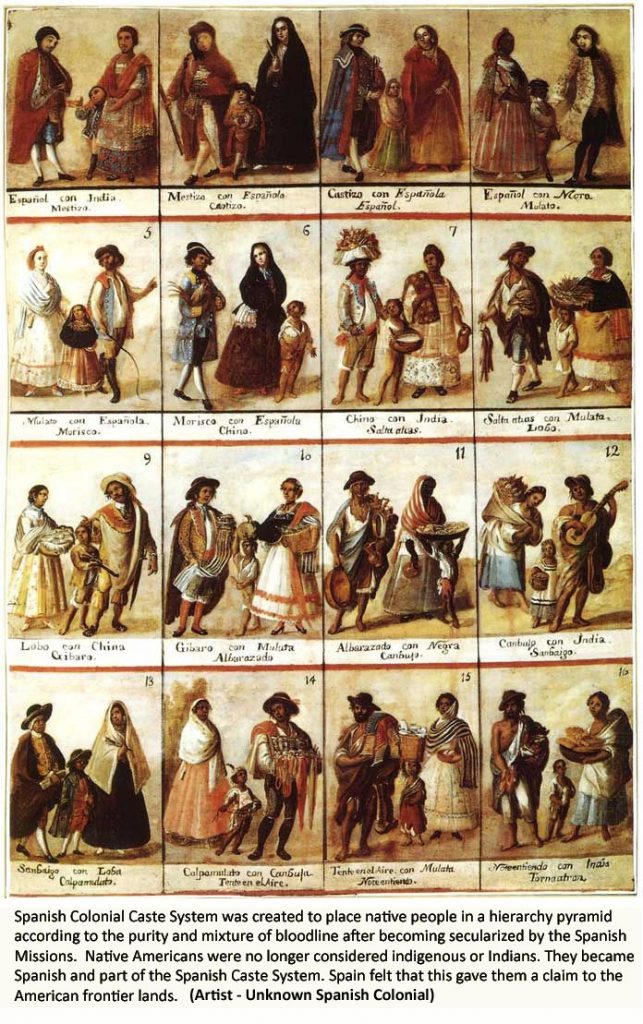
Five San Antonio Missions were established near the San Antonio River. Baptismal records from two of these missions included ancestors of Butte Indians: San Valerio (the Alamo) and San Fernando. For the Butte Tribe, baptismal records for the majority of their ancestors as well as death and marriage records came from San Fernando Mission. In 1793, San Valero Mission was considered secularized meaning that Indians in that mission were no longer considered Indians of Texas. They were now Spanish. As Spanish, they became the lowest members of the Spanish cast system.
WHITE SMOKE & TWO MOONS

Franco Jose Pereda Montano aka Chief White Smoke, first chief of Butte Indians of Bayou Bourbeaux, was baptized at Basilica of Saint Joseph and Our Lady of the Heart Catholic Cathedral in Mexico City on 10 March 1778. His parents were Juan Pereda and Mari Antonia Montano.
Ana Maria Leal aka Two Moons, wife of White Smoke, was baptized at La Purisima Concepcion (Temple of Immaculate Conception) in Sinaloa, Mexico, on 13 February 1782. Baptismal records states that she was born on 26 January 1782 to her parents, Juan Jose Leal and Gertrudis Corvera.
The next account of their existence was found at San Fernando Mission at the baptism of their first child. Jose Francisco Pereda was listed as birth father of his son, Joseph Pereda Desadier, on 10 Feb 1798, who became the second Butte Chief. This document also named his wife and mother of the baby as being Ana Maria Leal.
Note: The picture above is not proven to be an actual sketch of White Smoke and Two Moons. The sketch in from a photo that was found in a family album with the names White Smoke and Two Moons written on the back of the photo. The photo belonging to Felix and Fee Desadier which was passed down to their great-grandson, Chief Rodger Collum. Since the sketch was a photo, it is not likely the first chief and his wife since they were born in the mid-1700s before cameras were invented. It is possible that these people are related to our family.
ESCAPING THE MISSIONS
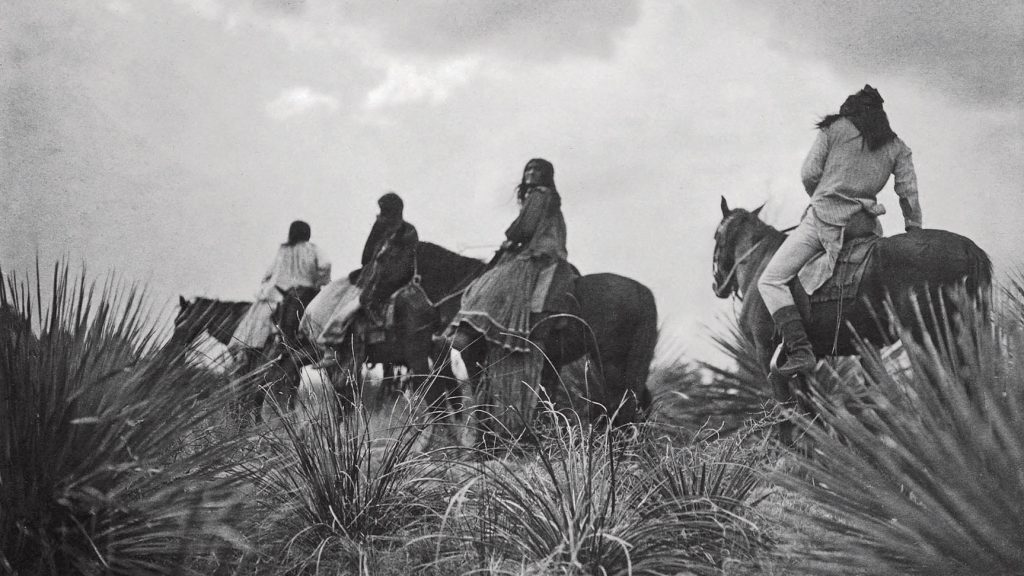
White Smoke and Two Moons made their way to San Fernando Mission from Mexico before the birth of their son in 1798. The story of their arrival at San Antonio Missions is a mystery. What is known are the stories that were handed down from the elders to Chief Collum. While at the missions, White Smoke worked on a mission ranchero. Ranching was the most profitable activity for the missions. It was also the source of greatest contention between neighboring missions and towns people because of raiding Apache, Comanche, and Washita Indians. San Fernando was the hot-spot of an active contraband trade between Central Mexico and Louisiana.
Life at the missions was everything that White Smoke loathed. Suppression of his people’s native customs, forced enculturation and strict/rigid teachings of Christianity. He waited until the birth of his child to make an escape. His plans were in order. His band of braves waited for his command.
Some ranchos had compounds built for the purpose of housing Mission men and their families. In White Smoke’s case that worked to his advantage. When time arrived, they escaped the ranchero with a wagon and a small herd of horses. Leading up to the escape, White Smoke traded furs and horses with the French for guns and ammo. He timed their exodus in such a way that it would give his band as much of a head start as possible. Their destination was the Louisiana woodlands across the Red River. Buffalo roamed there. Many of White Smoke’s family waited in the woodlands for his arrival.
White Smoke was a spiritual man. He believed that the Great Spirit was leading him to a place of green grass and buffalo. The band worked its way toward their destination, stealing and raiding when the opportunity arose. Weeks later, they crossed the Louisiana territorial line with horses, furs and a stash of other contraband. White Smoke and his followers found the land of the Great Spirit. On this land his people would live the life intended for them to live.
THE APACHE
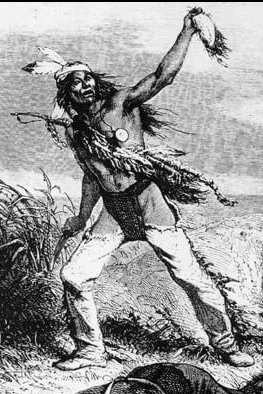
The elders told a story of White Smoke on the trail to Louisiana. One late afternoon, the band was making camp for the night. One of the scouts came riding into camp to warn his people that a raiding party of Apaches was headed their way. On their arrival, White Smoke and his men were waiting for them to battle on horses with painted faces.
White Smoke was known as a mighty warrior. He had no fear of death and he coveted bouts to the death to show his prowess. The Apaches saw that White Smokes band was waiting for them. They stopped about 50 yards from their rivals. White Smoke moved forward on his horse waiting for the Apache leader to meet him in the middle of the battle field. As the two leaders faced each other, White Smoke called out “Gósé” in the Apache language as he looked at his opponent with cold-black eyes, a smirk on his face. The Apache turned red-faced and challenged White Smoke by raising his lance and shouting. The challenge was accepted as both rode back to their band of men.
White Smoke’s horse was high-strung with anticipation. It knew his masters touch. As White Smoke turned to face his opponent, he slightly touched his stud’s belly. The horse reared up on his hind feet and leaped forward to meet the challenge of his master.
As White Smoke road past the Apache, he reached out with a slight touch of his spear and sliced the cheek of the Apache. As he turned to ride back to his men, he called out “Gósé” once again to humiliate his adversary. He continued the mocking while his horse stood still and shivered. With one small touch, the horse rushed forward as White Smokes’ spear found its mark in the heart of the Apache. White Smoke jumped from his horse, snatched the hair of the Apache, and with one quick, sharp slice of his knife raised the scalp high in the air with a loud war cry. The elders told Chief Collum that White Smoke enjoyed humiliating his opponent before the kill. (“Gósé” was the Apache word for dog.)
HUNTING CEREMONY
During hunting season, tribal men would gather for tribal hunts. Before each hunt, a traditional hunting ceremony was offered to the Great Spirit. Braves would gather at the appointed spot set by White Smoke. Upon arrival, White Smoke would sit in an open space on the ground with his sacred pipe. Braves would then form a coiled circle around their chief as White Smoke began chanting a prayer to the Great Spirit to bless the hunt. He took a smoke from his pipe. Each brave would take a puff of the pipe as it was passed around the circle. When the last man took a smoke, the band took to their horses and began their hunt. Whatever wildlife that was killed was divided between clans and shared with the entire tribe.
PIT-FIRE LOG
Butte elders told a story of three visitors from the Upper Yatachez tribe. While there, they raped a Butte girl and left her for dead in the woods. When the girl could not be found in the village, a search party was sent out for her. It wasn’t that long before she was found horribly raped and injured. Surprisingly, she was still alive and able to name her attackers.
The Yatachez were on the trail home when White Smoke’s band caught up with them. Brought back with hands bond, running behind trotting horses, the three Indians were forced to return to the Butte village. As they arrived, they were pulled through two lines of angry Butte women who were screaming and beating the molesters with sticks and stones. The men were tied to stakes in the middle of the village and left there until justice was served the next day.
When the next day came, the three men were taken to a place outside of the village. A flaming fire with red-hot coals was burning in a deep pit. Across the pit was a huge log. On this spot, one of the captives was set free. White Smoke was waiting at one end of the log. The captive was given a knife and stood at the other end.
As they mounted the log from opposite ends, they met in the middle where White Smoke took first blood by slicing the captive’s cheek. The captive was taken by surprise and almost lost his balance. White Smoke stepped back to mock the captive’s expression of fear. This continued until White Smoke tired of his play and the captive lost his battle with the log and fell into the pit of fire. The games continued until White Smoke’s justice was poured out on all the captives. At the end of the game of the pit-fire and log, White Smoke was awarded the sacred fan of red feathers. The fan remained in his lodge until the next battles were fought and a new winner was declared.
CONTRABAND TRADE
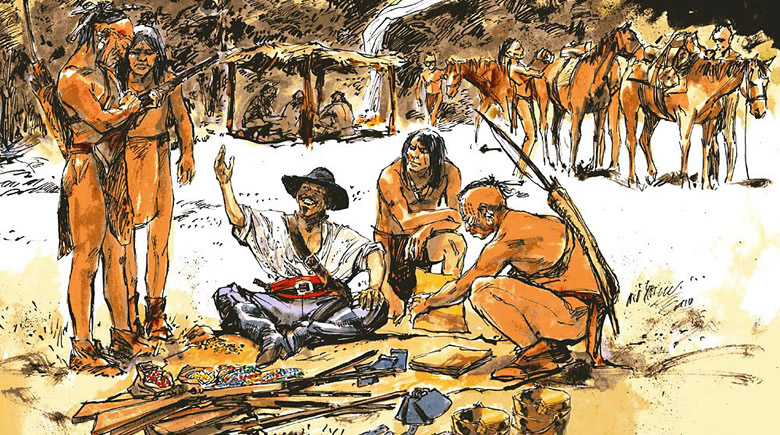
White Smoke and his descendants, Joseph Sr., Joseph Jr. and Felix, were heavily active in contraband trade. This trade involved the movement of illegal cattle, horses and other trade items over the Texas territorial borderlines. Spain and Mexico opposed all trade with any country east of the Texas border. Contraband was the life-blood of the Butte Tribe. The long ongoing trade between White Smoke and Texas was too profitable to squelch his desire in his contraband movement. Butte traded heavily in cattle, horses, furs, salt, cotton, tobacco, and other agricultural crops.
When running contraband across Texas lines, there were specific contraband trails that were traveled to bypass the main roads where officials would be waiting. For White Smoke, his trail led straight through Bayou Bourbeaux. Today you would find that mustang route by following US Highway 84, through Bayou Bourbeaux on LA Highway 1226, all the way to the Sabine River.
UNWELCOMED SETTLERS
Butte Tribe has spent a lifetime protecting its land from outsiders. When settlers from the East started their move West, they had no regard for the indigenous people of America who had for thousands of years respected and cared for the land that belonged to them. Stopping on Butte land was not a wise thing to do.
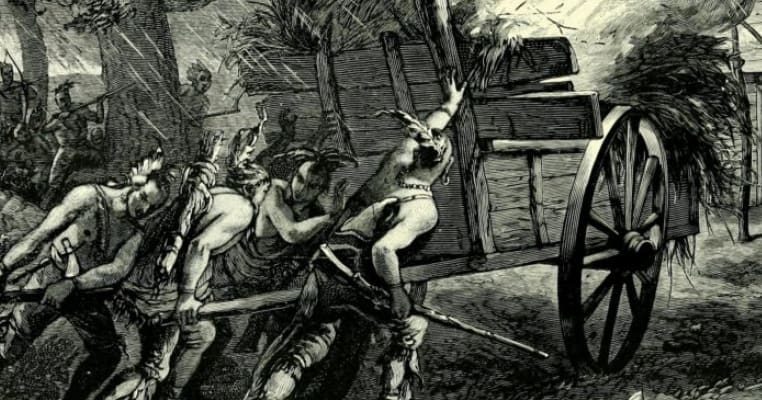
Twelve Scottish fur traders traveling on horses with a wagon full of supplies decided to set their stakes on Butte land. They stopped at the old Lemoine’s place on the Indian Trail and set up camp. As they settled down for the night, they had no idea of what tomorrow would bring.
As the early morning sun came up in the East, a few bird calls and a little rustling of horses could be heard. A sudden loud, sharp yelp filled the air. Startled, the intruders grabbed for their weapons but were not fast enough to hold back the swam of natives attacking them. White Smoke, his son, Powder Face, and the rest of the band, attacked the hunting party so fast that the men didn’t know what hit them. Warriors came from everywhere: jumping from trees, behind bushes, riding horses down the trail. When the smoke had settled, twelve scalps were hanging from the warriors’ belts. Twelve bodies were burning with the blazing wagon. White Smoke, great warrior and tormentor, returned to his village with a small herd of horses, a load of hunting supplies and a bloody scalp hanging on his spear.

When Chief Collum was told this story as a little boy, his grandfather, Chief Clarence Desadier, took his grandson to the exact spot of the attack. At that time, there were several pieces of the wagon that remained as proof of the attack. Today, the only thing that remains is the rim of a wagon wheel that surrounds two trees that grew through it.
FORT SELDEN
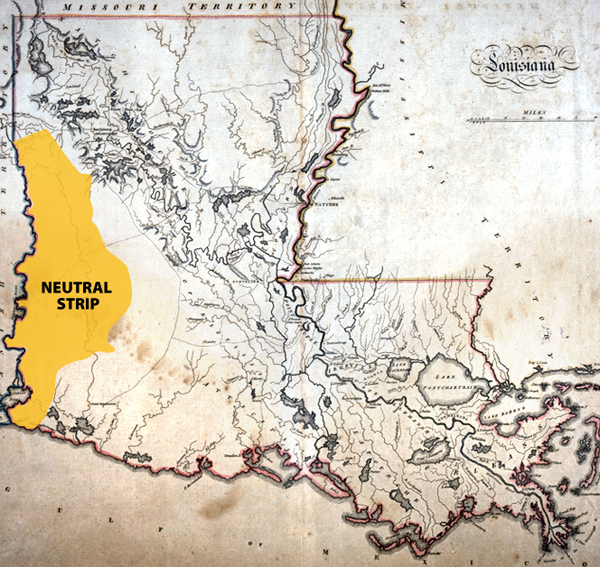
Fort Selden was established in 1820 by the United States as a temporary means of controlling the waterways between the United States border and the Neutral Strip between the US and Mexico. It was located north of Natchitoches, south of Bayou Pierre, on the highest hill in the area. The purpose of the fort was to keep a watch on the borderline and protect inhabitants within that area. The strip of land between the two territories was called No Man’s Land which was formed by a treaty between Mexico and the United States until a decision was made on where the Texas borderline was going to be placed. This strip was controlled by neither country. It was a lawless place where Indians among many other unruly people were pressing for rights of freedom against all odds.
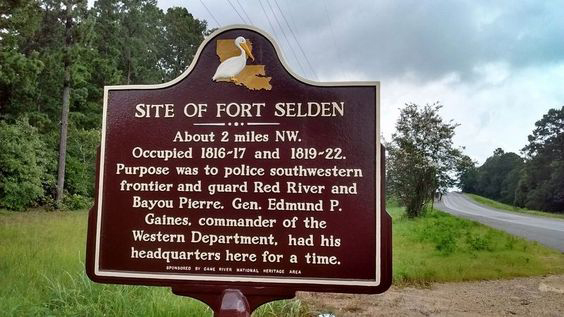
White Smoke along with other tribes in the area recognized no treaty with white men accept the one’s that benefited his people. Bayou Pierre was a main waterway for Butte Indians. They hunted and fished on its waterway. They carried contraband by water there. White Smoke was not pleased with the placement of the fort. He was even more unpleased with control of the waterways by US military.
One early morning before daybreak, the Buttes loaded up in canoes on Saline Bayou headed for the river. From the river, they traveled North until they came to the first curve in the tributary and turned left to follow Bayou Pierre. White Smoke was careful to dock the canoes before he made visual contact with Fort Selden. Working their way silently through the woods, the fort guard was surprise with a firm hand grip over his mouth and a knife across his throat. Part of the braves entered the fort and began raiding the supply house for guns, ammo and any other thing of interest. The rest made way to the military horses. By the time the regiment got wind of what was going on and rushed for their weapons to stop the intruders, White Smoke’s braves were on their way to South Louisiana to cross into Mexican territory to trade the horses at the Rio Grande.
BOWIE BROTHERS

James “Jim” Bowie (1776-1836) known for his expertise with the famous Bowie knife was raised and spent most of his life in Louisiana. In the western parts of Louisiana, his brother, Rezin, and he were best known as con-artist in land speculations as well as slave smugglers and chasers. The Bowie brothers partnered in 1818 with the well-known pirate Jean Laffite in the illegal smuggling of African slaves on the coastal lands of Louisiana. Slavery for those slaves who were already in the country was still allowed. It was illegal to bring new slaves from foreign countries to the United States.

The Bowies paid Laffite a dollar a pound for his slaves. These lost-but-found smuggled slaves were turned in to authorities for bounty. The salves then became property of the Bowie Brothers and were sold on the auction blocks in New Orleans for a huge profit.
It was on one of these excursions that ten slaves escaped the capture of the Bowie Brothers. With the help of local anti-slave, underground people, the slaves made their way from southwest to northwest Louisiana.
Native Americans were sensitive to the plight of African slaves in America. Red and black skinned people where on the lowest level of the cast system. The run-away slaves found their way to the Butte village.
Several days later, the Bowies rode toward Bayou Bourbeaux with a native tracker. As they rounded a corner on the wooded bayou trail, an arrow landed ground at the feet of Bowie’s horse. Waiting for them was White Smoke and Powder Face. The tracker greeted White Smoke respectfully. White Smoke knew the tracker but did not return the greeting which was a definite sign that it was time the intruders turned around, left the way they came and prayed they got away with their scalps.
Bowie had heard of White Smoke and knew that this was a band of Indians that he did not want a confrontation with. There would be no trading done with White Smoke regarding slaves. If White Smoke had them, they were lost to Bowie. Bowie turned his party around and headed back toward the direction they came from.
DEATH OF WHITE SMOKE

White Smoke lived a long life. In his lifetime, he took the lives of fourteen of his enemies. The date of his death is not known. What was known is that he lived to know his grandson, Joseph Desadier Jr., who was born in 1832. His son, Chief Powder Face, Joseph Pereda Desadier, buried his father on Butte Hill. White Smoke’s grave was dug deep but not wide. He was buried standing up with his arms crossed. Inside his hands was placed his sacred pipe. At her death, Two Moons was buried beside her husband lying flat.
Two large natural stones with etchings carved on them where placed on their graves. White Smoke’s stone was etched with and “X” to represent a campfire and wavy lines on top of the “X” to represent the smoke rising from a campfire. Two Moon’s stone had two circles representing moons. So went the life of White Smoke, the first and greatest of chiefs of the Butte Tribe of Bayou Bourbeaux, buried on Butte Hill.
CONCLUSION
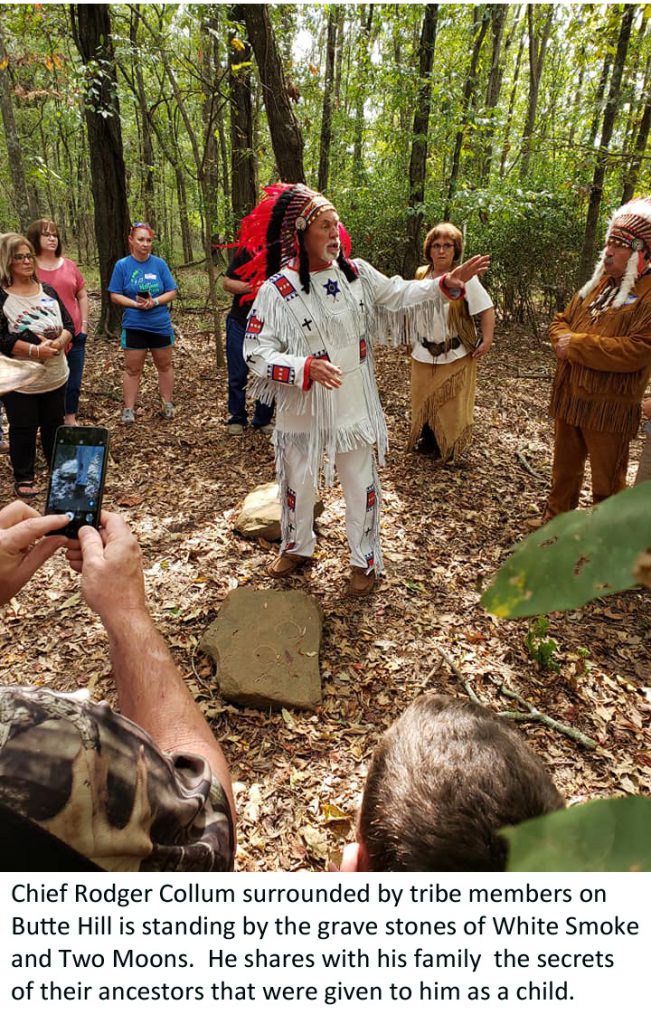
Six chiefs have been trusted with the guarded secret of Butte Hill. One chief, Chief White Smoke, was buried there on top of the sacred mound of Butte Hill. Generations of family members lived their lives not knowing White Smoke or the stories of their Native American heritage. Only the elders knew the stories. These stories were handed down to the next hand-picked leader of the tribe. This leader was chosen at an early age by the acting chief at that time. The elders believed that the day would come when their stories could be told without fear of the destruction of their people.
Chief Rodger Collum was the chosen one by his predecessor and grandfather, Chief Clarence Desadier. From the age of five until he was sixteen, Rodger sat at the elders’ feet to listen to the stories of his ancestors. At the time, even he did not understand the importance of what had been given him. When he asked, “Why can’t I go out and play?” his grandmother would say, “Because you are special.” Should he be distracted by the cousins playing outside, an elder would thump him on the head and say, “Pay attention, Rodger Lee, you will have to repeat this one day.”
Rodger always knew that he was the family leader. It wasn’t until Rodger became a man and his ancestors had passed that he realized the importance and the responsibility of the knowledge that had been passed down to him. The Great Spirit honored the prayers of his elders and sent a revealer to inquire of the elders’ revelations.
When asked, “Why after all these years have you decided to go public with your tribe?” Chief Rodger Collum replied, “My ancestors raised me for such a time as this. It is time to reveal the secrets and tell the story of my people.”
The secrets of the Butte Tribe began at Bayou Bourbeaux over two hundred years ago. Only a handful of warriors at any given time knew the secret of Butte Hill. The few that did spent a lifetime guarding it.
Note: Butte Tribe lineage is a uniquely mixed tribal bloodline (Texas and Chitimacha Indian) of ancestors who were born and raised on Bayou Bourbeaux in Natchitoches. All Chitimacha bloodlines come directly from Marie Anne Therese De La Grande Terre and/or her sister, Marie Jeannie, who were Chitimacha captives of St. Denis’ raid of a small Chitimacha village in Mobile, January 1708.
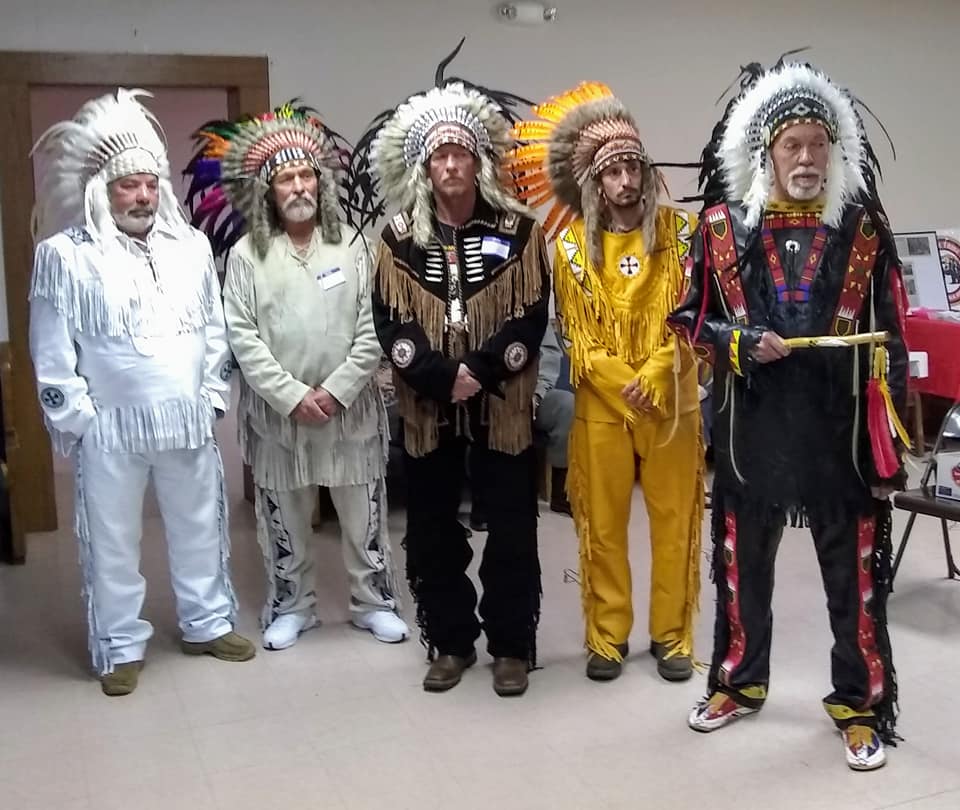
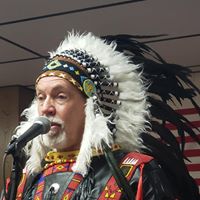
By: Belinda Brooks

Saturday, March 14th, Butte Tribe members met for their Spring 2020 seasonal meeting with approximately 100 members attending. The meeting was held at the Pace Recreation Center in Natchitoches, Louisiana. Special guest was Eric Kirkendall, Shreveport Ambassador of Ansley’s Angels of North West Louisiana.
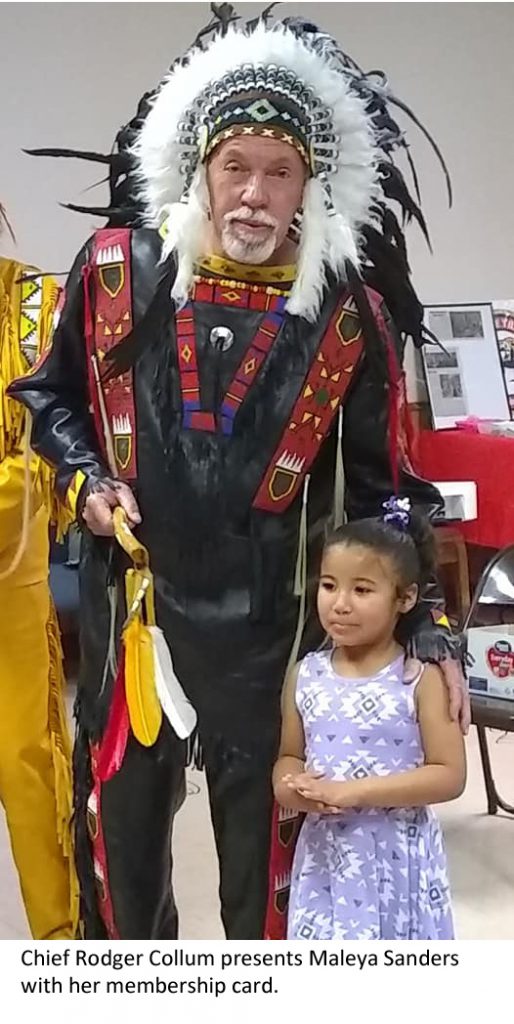
Members gathered for their quarterly business meeting. Chief Rodger Collum reported on the Butte Tribe Cultural Center Project that is now in process. Land survey and tribe pledges were discussed. He discussed his recent meeting with the Natchitoches Police Jury and the requirements that are needed to put tribe plans into action. Treasurer Brad Desadier gave the financial report. Vice-Chief Belinda Brooks spoke to the tribe about the current series of articles on the Butte Chiefs of Bayou Bourbeaux that is being published the Natchitoches Times newspaper. Members were encouraged to take time to read the articles to learn more about the history of their tribe.
New membership cards and feathers were handed out to the members who were present. Approximately 100 new members were added to the tribal rolls. Presentation of feathers is a ceremonial event of the Butte Tribe. Traditionally, both men and women wear feathers within the Butte Tribe. Feathers must be earned and the decision of who receives feathers is made by the chief.
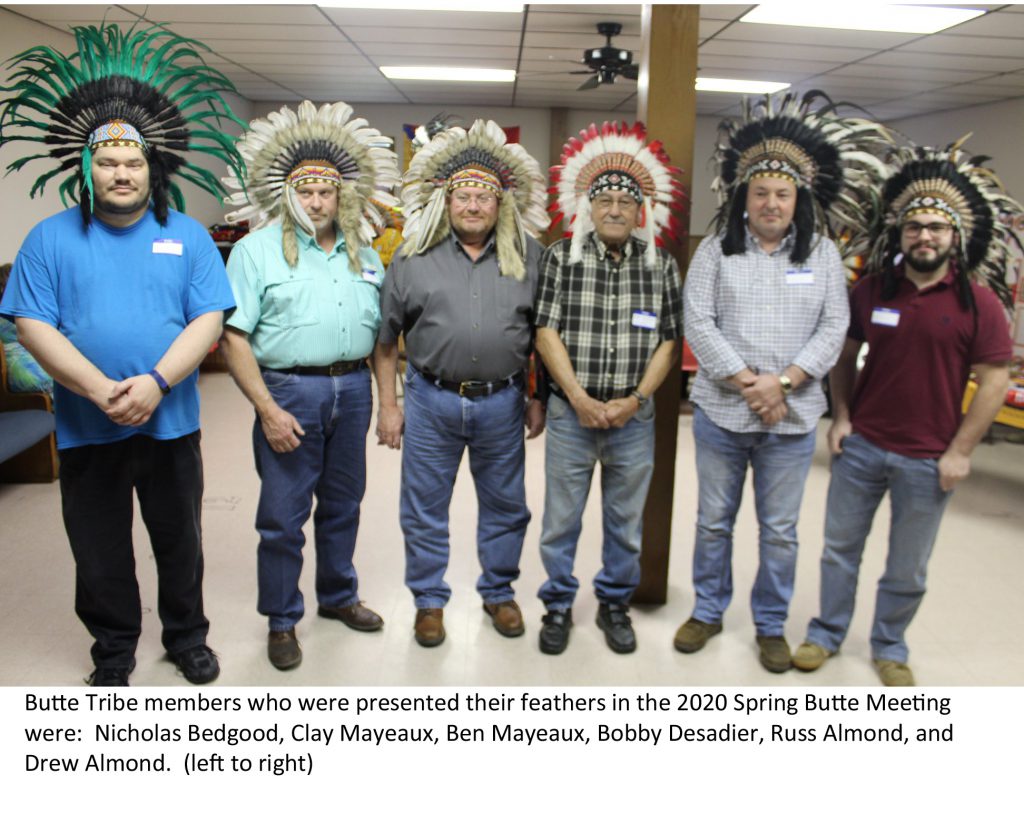
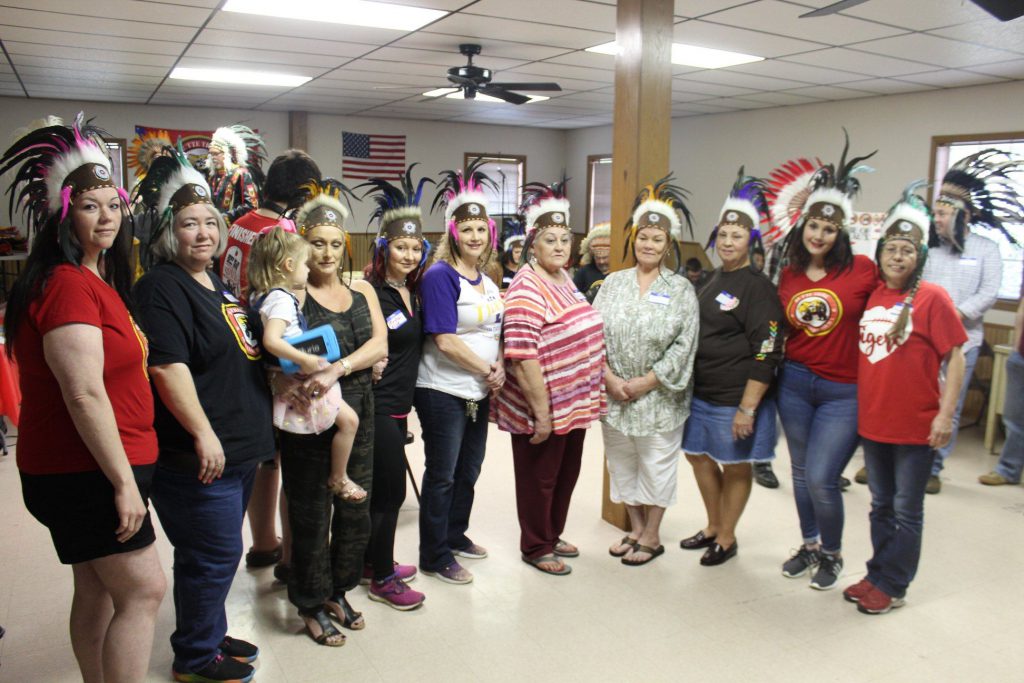
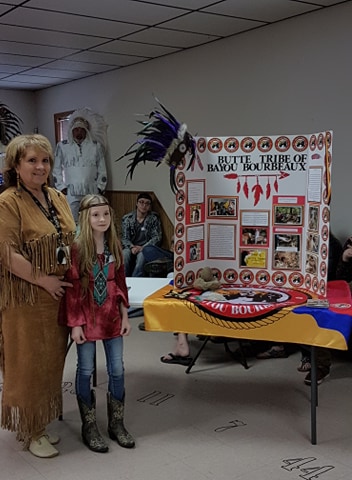
Raven Trichell, Butte member, displayed her history presentation that will be entered in 2020 Louisiana State History Fair competition in May. The Butte Tribe presentation won the Overall Championship Honors at the regional competition in Monroe, Louisiana.

Meshal Kavalir Free, Butte member, invited special guest, Eric Kirkendall, Shreveport Ambassador of Ansley’s Angels of North West Louisiana. Free is an avid supporter and volunteer of Ansley’s Angels. Her son, Will, loves to ride with his mother guiding the wheels. Free and Kirkendall expressed their feelings of joy when at the end of marathons their riders receive metals just like those who could actually run the race. Kirkendall spoke to the tribe about his non-profit organization, Ansley’s Angels. Rides were provided for those at the meeting who wanted to experience the fun of being pushed at a running pace down the highway. Ainsley’s Angels provides exciting bike riding experiences for disabled children of all ages. Specially designed four-wheel push-bikes that enable the riders to sit safely and comfortably are pushed by volunteer runners to enable the riders to enjoy the thrill of road gliding and to feel the breeze of air brushing by their bodies.
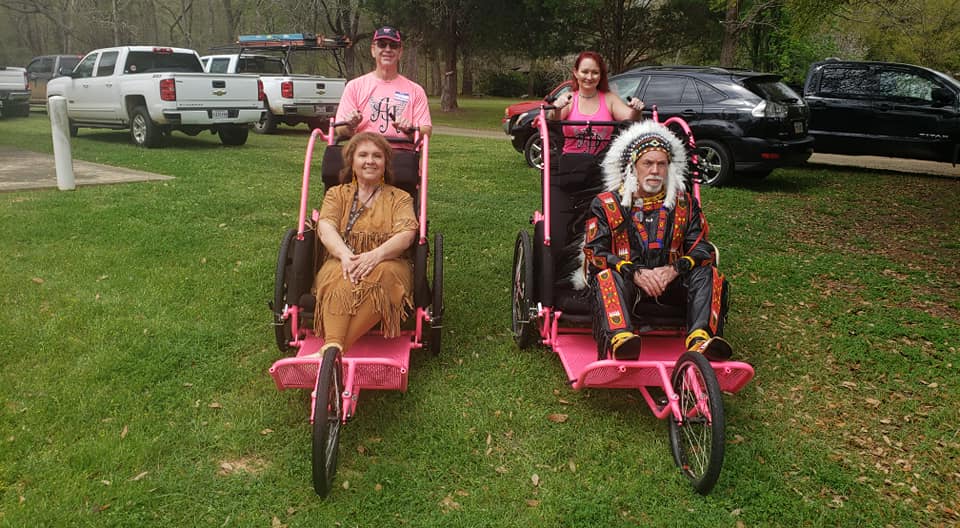
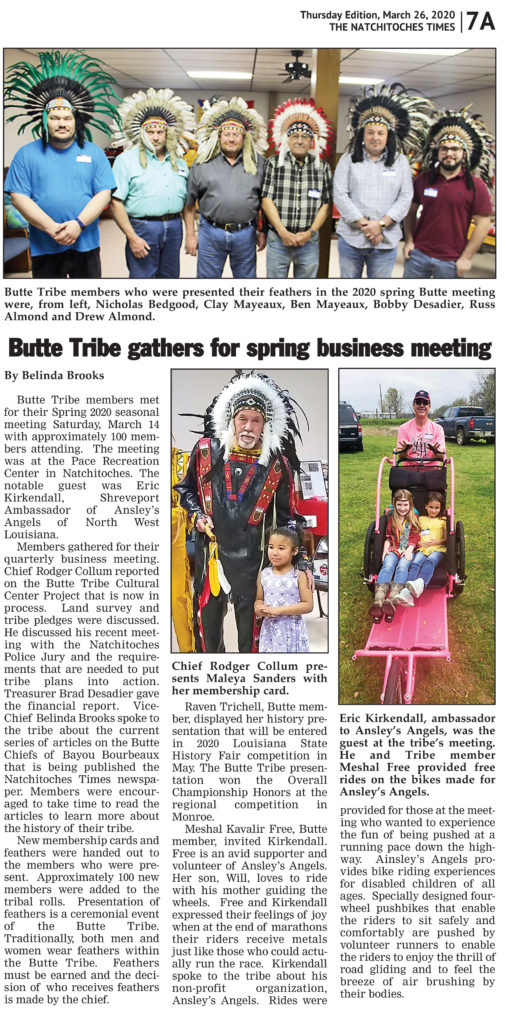

Written by: Belinda Brooks
Oral History by: Chief Rodger Lee Collum

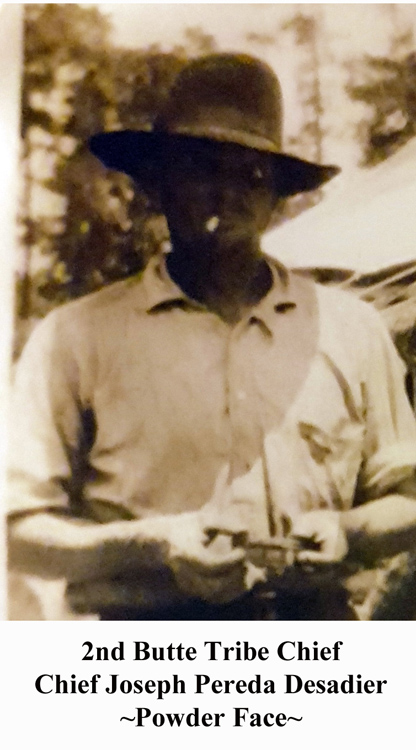
Chief Joseph Pareda Desadier (Joseph Sr.,) 2nd Chief of the Butte Tribe of Bayou Bourbeaux was born February 10, 1798, in the San Fernando Mission at San Antonio, Texas. Listed on the Mission’s baptismal records as his parents were Jose Francisco Pereda and Ana Maria Leal who were both natives of the city. Understanding Catholic baptismal records during the Spanish occupation, one understood that the Spanish’s purpose of converting Native Americans to the Catholic religion was their way of assimilating natives to Spanish culture and claiming their land for Spain. To the ultra-religious Spanish, the indigenous people of America were ignorant heathens who needed salvation.
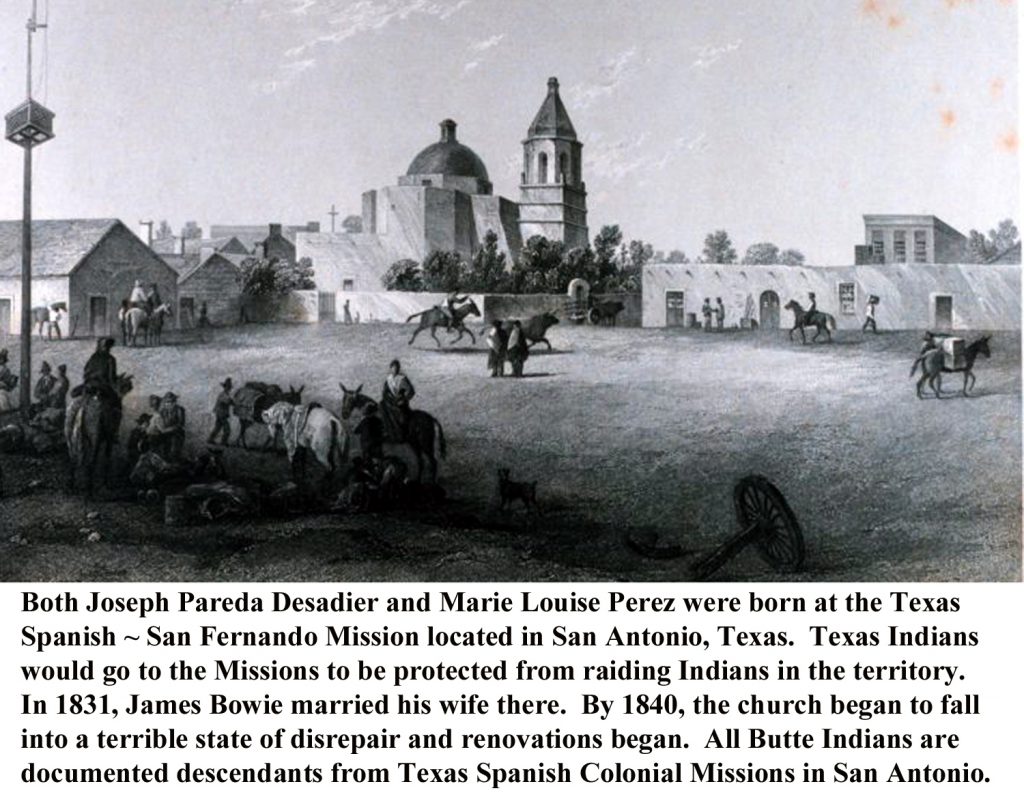
Therefore, Mission Indians were required to be baptized. Upon baptism, the priest would gift each native with a Christian name. That person would then become a Spanish citizen and no longer considered Indian. Christian names given to Joseph’s parents listed above were their baptismal names. Their Native Americans names were White Smoke and Two Moons. The story of their escape from the missions to Bayou Bourbeaux will be revealed in the next and final story of the Chiefs of Bayou Bourbeaux.
As Joseph grew, he earned the native name of Powder Face. When a Butte raiding party would ride out from the village, Joseph’s signature painted face was made with water and white powder. The mixture made a white paint that he used to paint his face solid white. Raiding, killing and torturing their enemies were not given a second thought when it came to protecting their lands and family. Joseph made his first kill at the age of 15. At that time, White Smoke considered his son a man.
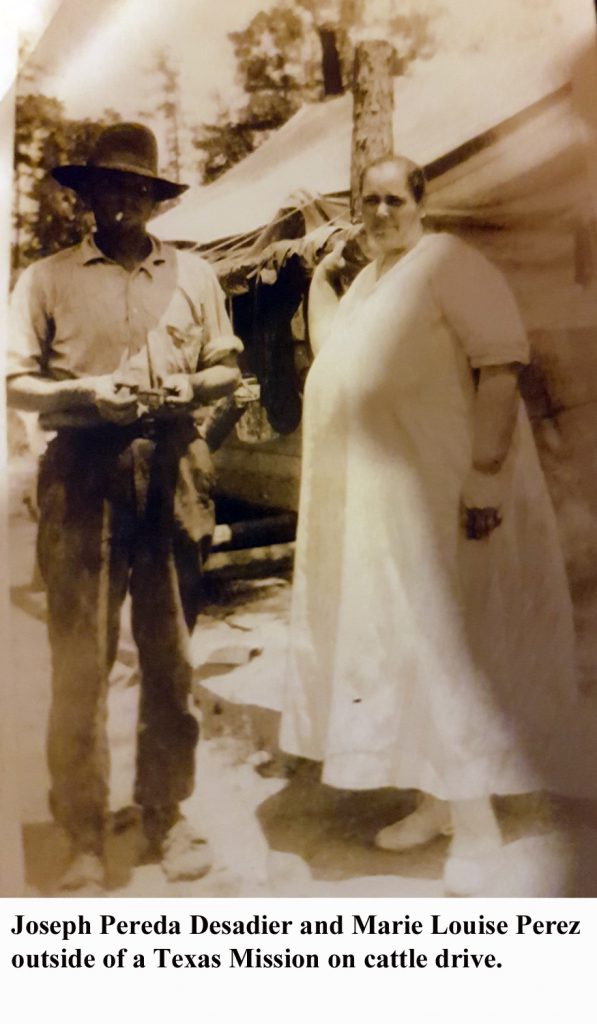
In 1827, Joseph Sr. married Marie Louise Perez. Marie Louise was older than her husband, and like Joseph was born in the San Fernando Mission in San Antonio, Texas. Her family migrated to Louisiana by way of Opelousas, Louisiana. From there, they found their way to Bayou Bourbeaux. She met Joseph there where they raised their family.
TRADE
Trading goods with other tribes and Europeans was a way of life with natives. As a young man, Joseph spent most of his life on the rivers and trails of North America bartering for goods needed by the family. The most popular trade item Buttes had was salt which was gathered from the Goldonna salt licks. Goldonna’s clan was part of the Butte Tribe. Joseph and other young tribal braves would travel the Saline Bayou to Goldonna, back to the Red River; from there, the band of braves would go south to New Orleans, Mexico, South America, or travel north. Butte Tribe traded for items such as bear grease, flint, rock, etc. These trips could last as long as six months or longer. When the braves returned, their first stop would be at the temple mound. There they would leave their best gifts and make their way to the village. The tribe would celebrate by sitting around fires, smoking pipes, telling stories, singing, dancing, and eating specially prepared foods.
PROTECTING BUTTE LAND
Joseph Pareda Desadier was raised on the Louisiana prairie grass and bayou land of Bayou Bourbeaux. His father, Chief White Smoke, moved his people to this land shortly after his birth in 1798. White Smoke controlled all the lands and tribes in the Bayou Bourbeaux area. The prairie grassland was abundant with thousands of buffalos and other wildlife. The buffalo was very important to the survival of the Indians. Native Americans would only kill enough buffalo to supply their needs. Every part of the buffalo would be used and nothing wasted.
Since the Louisiana Purchase in 1803, White Smoke met with the territorial Indian Agent, John Sibley. Sibley’s main job as agent was to prepare area tribes for governmental land survey. Sibley assured White Smoke of the “Great White Father’s,” President Thomas Jefferson’s, promise that Butte tribal land would be held as sacred land and the government would not take one acre of their land without White Smoke’s consent. Having lived and escaped from the Texas Missions, White Smoke had no trust in the words of white men. Joseph was raised with the knowledge of all the things that his people had lived through.
As time passed and the government changed leaders, Andrew Jackson became the 7th President of the United States in 1829. Jackson wasted no time targeting Native Americans. In his 1829 State of the Union Address, Jackson called for removal of Native Americans from the southeast to Texas and Oklahoma territories. By forcibly removing the Native Americans west, the Southern states would gain the ill-gotten land that belonged to the natives. The Indian Removal Act was signed in 1830 and put into action immediately.
Joseph and his father were waiting. European settlers had tried to claim their land many times before. Their plan was put into action. The family would first assimilate to the white man’s ways. Then, they would watch and be ready. Next, everyone knew what shutting down the bayou meant. It had happened before. It would happen again. Beware to settlers who dared to cross Butte land!
CATTLE DRIVES
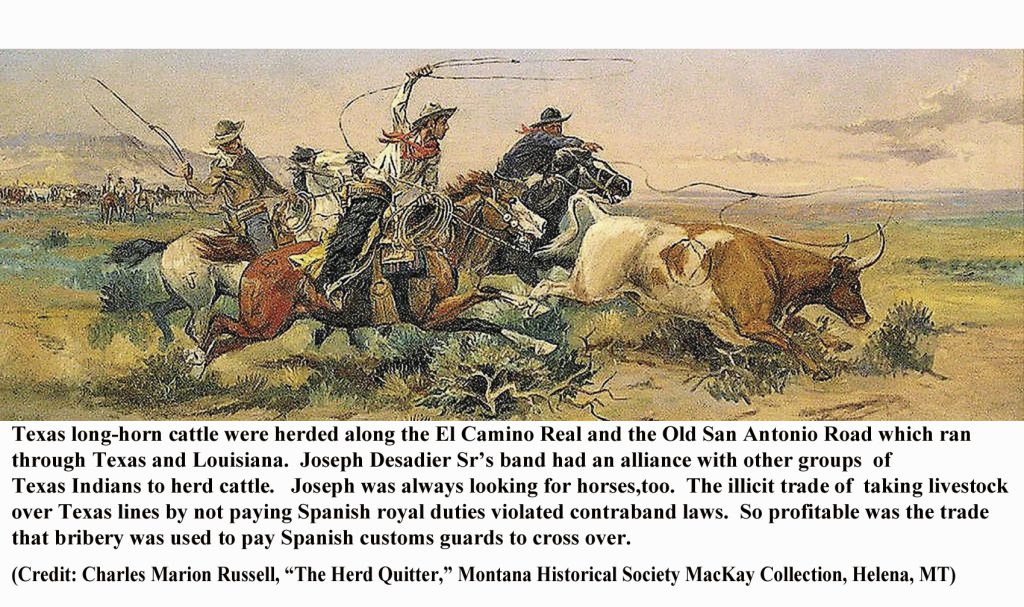
As time passed, white settlers soon found their way to the bayou lands. Oddly enough, there were no white settlers on Butte land. But, the rich land and abundance of wildlife around Natchitoches Parish were too enticing for settlers to resist. They started marking off land near Butte land with no thought of natives who had lived on the land for hundreds of years. Buffalo were being slaughtered. Contention between Native Americans and whites were high. The senseless killing of numerous buffalo for sport by white men left little for the natives’ lifestyle. By the 1830s, there were very few buffalo left on the prairie.
Joseph had to start a new chapter in the lives of his people. Horses and Texas long-horns were where Joseph’s new interests lie. Joseph would travel anywhere to find the fastest, most stunning horses. He was known far and wide for his outstanding walking and quarter horses. Texas long-horn cattle were free-range cattle. They were there for the taking and the market was in high demand. One steer could bring ten times its cost. As a good business man, Joseph couldn’t pass that up. He with his band of men traveled the El Camino Real and Old San Antonio Trail often to return with hundreds of heads of cattle to sell or trade on the open market in New Orleans or at the docks on the Mississippi River.
Joseph ‘s wife, Marie Louise was away from her home one day when she was attacked by a raiding group of Indians led by a warrior named Red Hawk. She took an arrow to her arm, was scalped, and left for dead. Within a short time, Joseph got word of the attack. It only took a few minutes to don his painted face, saddle up his fastest, gather his raiding party and hit the trail heading for St. Maurice.
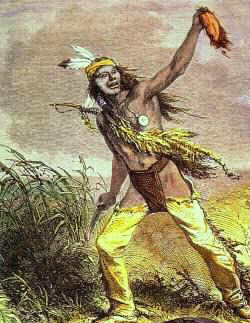
Joseph aka “Powder Face” knew his enemy, Red Hawk, well. Red Hawk and his men were known for stealing livestock and killing settlers in the surrounding area. The attack on Marie Louise may have been by accident with Red Hawk not realizing who he was attacking until the deed was done. Whatever the case, he had Powder Face to deal with now. The two bands clashed on the trail to Winn Parish near St. Maurice. Powder Face, angry and ready to draw blood, rushed in on the offending band of Indians. He only had tunnel vision for Red Hawk. As he drew near to Red Hawk, he leaped from his horse with a sharp war-cry and attacked. Both warriors hit the ground, quickly jumping to their feet, and drawing their knives for hand-to-hand battle. Powder Face drew first blood by slicing Red Hawk across the face. He gave his rival a wicked grin. As was his custom, he backed fair enough away to taunt Red Hawk for his weakness. Red Hawk reached up to touch the deep slash on his face. In anger, he rushed toward Powder Face who stepped aside taunting Red Hawk again with a sparkle in his eyes. As Red Hawk turned around, Powder Face went in for the kill. The battle ended quickly after that with Red Hawk’s bloody scalp dangling from Powder Face’s lance. Powder Face kept the scalp on the end of his spear until the day he died. He was buried standing up with his arms folded around his lance adorned by Red Hawk’s scalp. As for Marie Louise, she recovered from the scalping, but her hand became infected and she eventually lost two fingers.
BUFFALO KILL

Another story that was told by the elders was about Joseph’s buffalo kill. There were few buffalo on the prairie. Joseph decided that he was in need of a buffalo to feed his family. As there was no refrigeration, the buffalo meat would be shared among the tribe families. The remaining parts of the animal would be used for other essential needs. He rode out to the prairie to find his mark. It didn’t take long to spot his buffalo. He rushed toward the buffalo with his lance held high. He hurled the lance in such a way that the spear pierced the buffalo through and through, killing it instantly, and pinning it to the ground. Looking back at his kill as he rode forward, Joseph saw the buffalo laying on the grass, the lance standing straight up with Red Hawk’s scalp blowing in the wind.
JIM BOWIE

Jim Bowie of Alamo fame and his younger brother, Reazin, spent the majority of their lives in Louisiana. Although Bowie has been honored for his stand in the Alamo, the truth of the story as the people in the Rapides, Winn and Natchitoches Parish knew it was that Bowie was a con-man, thief, killer and chaser/seller of slaves. His history with Butte Indians began early during White Smokes reign as chief, but Joseph Sr. had a run-in with him one night near the lost San Saba Silver Mines in Texas in the 1830s. Joseph’s band partnered with a small group of Texas/Caddo Indians to round-up steers to sell in Louisiana. They were camped down for the night when in the distance they heard horses riding in. Joseph and his band readied themselves for a fight. Whoever it was, at this time of night, was up to no-good.
When Bowie neared the camp, he and his men were ambushed by Joseph’s group. Bowie fought Powder Face aka Joseph Sr. in semi-darkness. In the fight, Joseph sliced Bowie across his arm. As was the way of both, White Smoke and Powder Face, Joseph backed off to return again for the kill. In the process of doing so, Bowie and his men ran into the darkness without their horses. Butte braves circled their animals and camp for the rest of the night. In the early morning, they rose, gathered their property with the additional horses left by Bowie and headed toward Louisiana leaving Bowie and his men on foot to tell their story.
DEATH OF POWDER FACE

Consumer demand for cattle following the Civil War caused a booming market economy. Steers costing $3 in Texas could easily bring the ranchers $30 a head on the open market. Therefore, Joseph was very active in the cattle trade.
One steamy, hot July day in 1868, Joseph Sr. was herding long-horn steers across Saline Bayou to market them at the Mississippi River docks in Concordia Parish, Louisiana. As Joseph moved on his horse across the bayou, a long-horn steer broke out from the herd from behind him. The steer’s horn poked the horse’s rump unexpectedly as the steer moved up to incase Joseph and his horse between cattle on all sides. Joseph’s horse was startled which caused Joseph to fall to the side of his saddle. His foot tripped up in his stirrup. Cattle continued to move forward pulling Joseph down beneath the water where he was unable to recover his balance and he drowned.
The Chief was buried about three-quarters of a mile from his 3rd great- grandson’s home, the 6th Chief of the Butte Tribe, Chief Rodger Collum. Joseph Jr. buried his father there with honors, standing up, with his arms folded around his sacred lance. Dangling from the lance ~ Red Hawk’s scalp.